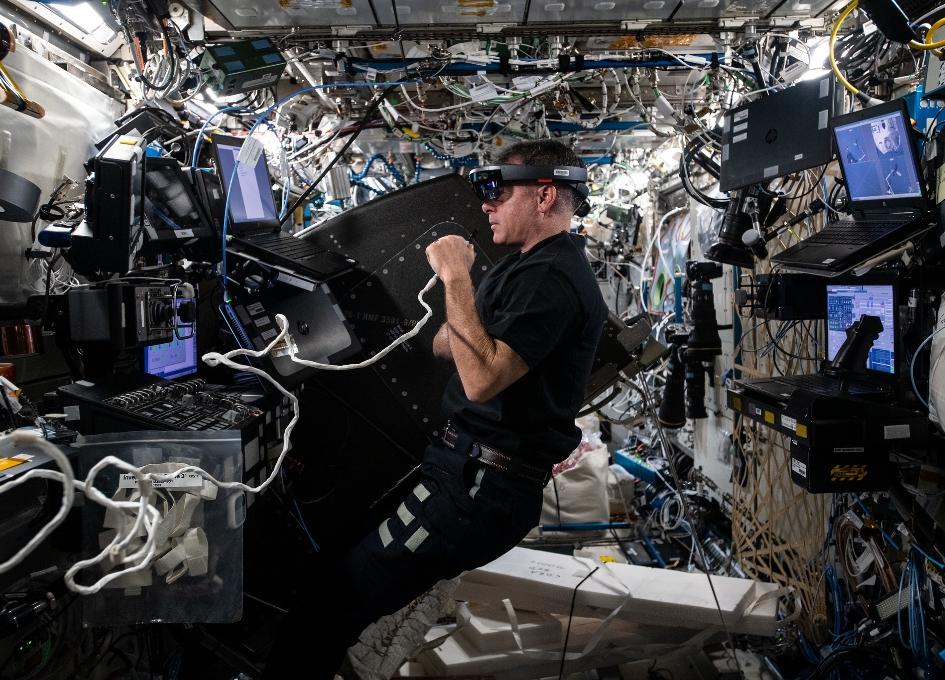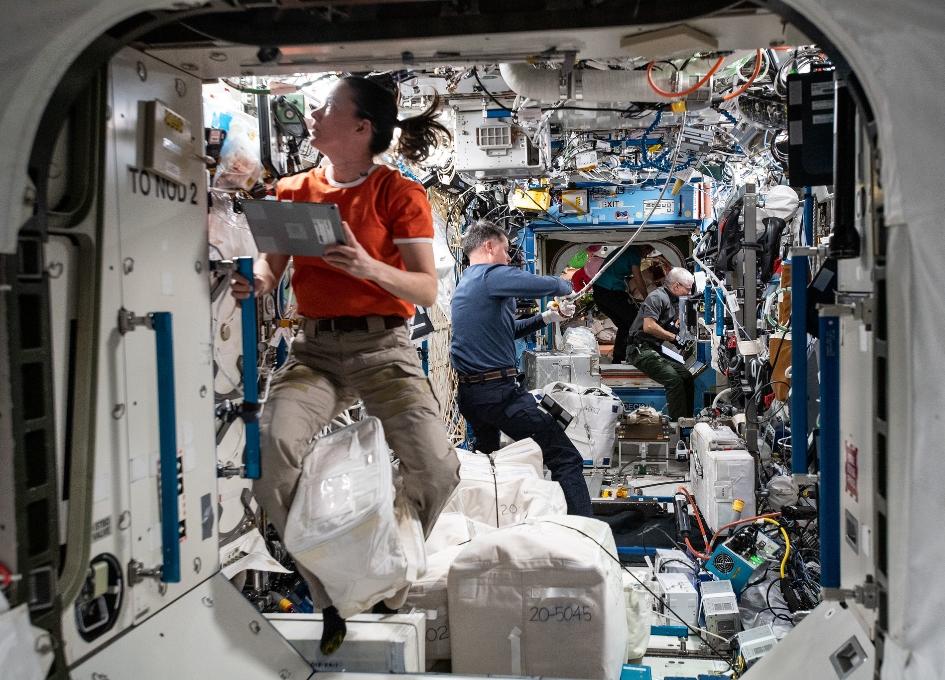
By cuterose
NASA Space Station On-Orbit Status 16 September, 2021 - 3D Virtual Reality Spacewalk Filming
A 3D virtual reality camera that filmed Sunday's spacewalk has been returned to the inside of the International Space Station.
Meanwhile, the Expedition 65 continued its space biology research and lab maintenance activities on Thursday.
A specialized video camera that filmed Sunday's spacewalk in immersive virtual reality was grappled by the Canadarm2 robotic arm and placed on a pallet outside of the Kibo laboratory module. The camera was retracted into Kibo's airlock Thursday morning where ESA (European Space Agency) Flight Engineer Thomas Pesquet retrieved and stowed it. The cinematic videos are part of a research program called ISS (international Space Station) Experience and are downlinked to Earth to excite and bring gravity-bound audiences closer to space.
NASA Flight Engineer Mark Vande Hei was the crew medical officer again on Thursday, this time scanning the eyes of Roscosmos Flight Engineer Pyotr Dubrov with an ultrasound device. Afterward, Vande Hei set up optical coherence tomography gear and imaged Dubrov's retinas. Eye health is critical during long term space missions as doctors continue exploring how microgravity affects vision.
Commander Akihiko Hoshide of the Japan Aerospace Exploration (JAXA) spent Thursday morning setting up computers and cables before reconfiguring the Cell Biology Experiment Facility for upcoming research. In the afternoon, Hoshide installed a light on a spacesuit helmet then worked on transfers from the SpaceX Cargo Dragon resupply ship.
Ensuring the station remains in tip-top shape, NASA Flight Engineers Shane Kimbrough and Megan McArthur worked on life support hardware in the U.S. segment of the orbiting lab. Kimbrough installed a new carbon dioxide remover in the U.S. Destiny laboratory module. McArthur replaced components inside the Tranquility module's oxygen generator.
Dubrov and Pesquet tested hardware installed in the Nauka multipurpose laboratory module that will soon communicate with and control the European robotic arm. Roscosmos Flight Engineer Oleg Novitskiy spent the day servicing orbital plumbing gear in the station's Russian segment.
On-Orbit Status Report
Payloads
Four Bed CO2 Scrubber: The crew continued with the installation of the Four bed CO2 Scrubber hardware by connecting power, data, and fluid lines. Four Bed CO2 Scrubber demonstrates a technology for removing carbon dioxide (CO2) from the atmosphere on a spacecraft. The technology is based on the current system in use on the ISS with mechanical upgrades in absorption beds, heater elements, and valves and use of an improved zeolite absorbent to reduce erosion and dust formation. A goal for next-generation systems is continuous operation for 20,000 hours without a failure, and this technology is a step toward that goal.
Light Ions Detector for ALTEA (LIDAL) Relocate 3: The crew placed the Light Ions Detector into its third configuration and installed a Radiation Environment Monitor (REM) detector on the Light Ions Detector.LIDAL is typically relocated roughly every 6 months to monitor different areas. The capability of the original Anomalous Long Term Effects in Astronauts (ALTEA) to measure the Linear Energy Transfer (LET) of protons and helium and the kinetic energy of protons and heavy ions was upgraded by the addition of the Time of Flight (TOF) system detector called LIDAL. LIDAL upgrades the ability of ALTEA to make measurements that can be converted, by dedicated software in real-time, into radiation risk coefficients - effectively enabling ALTEA to become the first ever dosimetric "risk meter" aboard the ISS.
NanoRacks Module-9: The crew gathered tubes 1, 2, 5, 6, 7 from Nanoracks Module-9 box s/n 1053, opened the green clamps on the tubes 2 and 7 and shook them to activate them. The crew held tubes 5 and 6 up to the video camera for observation, and opened the blue clamp on tube 1 to deactivate it. Following these activites, all five tubes were restowed. NanoRacks Module-9 consists of multiple student experiments housed within a NanoRacks Module container in individual mixture tubes.Some experiments require crew interaction to remove clamps in order to mix materials to activate and/or deactivate the experiments. The experiments within the module are returned to the ground for analysis
Standard Measures: The crew collected body, saliva, and fecal samples in support of the Standard Measures investigation. The aim of the investigation is to ensure consistent capture of an optimized, minimal set of measures from crewmembers until the end of the ISS Program in order to characterize the adaptive responses to and risks of living in space.Among other things, the ground teams perform analyses for metabolic and chemistry panels, immune function, microbiome, etc. These measures populate a data repository to enable high-level monitoring of countermeasure effectiveness and meaningful interpretation of health and performance outcomes, and support future research on planetary missions.
The ISS Experience: Following the extension of the JEM Airlock slide table into the JEM cabin, the crew removed the hardware used to support the ISS Experience EVA video events. The ISS Experience Z-Camera was most recently used to capture five events related to the United States On-orbit Segment (USOS) Extravehicular Activity (EVA) on Sunday, September 12th. The ISS Experience is a cinematic virtual reality (VR) series documenting life and research aboard the space station. Filmed over multiple months, the immersive VR series documents different crew activities - from science conducted aboard the station to preparation for a spacewalk.
Turbine Ceramic Manufacturing Module (T-CMM): Following the processing run, the ceramic module was removed and stowed. Unfortunately, the ceramic module leaked during processing resulting in an incomplete print. T-CMM demonstrates manufacture of single-piece turbine blade/disk combinations (blisks) in microgravity for commercial use. Manufacturing blisks in space could produce parts with lower mass and residual stress, and higher strength than those made on Earth due to greatly reduced sedimentation of the solution in microgravity.

Systems
Post Extravehicular Activity Activities: Today, the crew completed several activities following the successful completion of the USOS 4A ISS Roll-Out Solar Array Prep EVA on Sunday September 12th. The crew started the second regeneration cycle of the Extravehicular Mobility Unit (EMU) Metal Oxide (METOX) canisters by baking out CO2 in the METOX Regenerator Oven as well as installed the EMU Helmet Lights, EMU TV, and High Definition EMU Camera Assembly (HECA) onto an EMU Helmet.
Oxygen Generation System (OGS) Hydrogen (H2) Sensor Orbital Replacement Unit (ORU) Remove & Replace (R&R):Today, the crew performed an R&R of the OGS H2 sensor and cleaned the associated Avionics Air Assembly (AAA) inlet.The H2 sensor R&R is routine maintenance activity and is necessary due to nominal degradation of the H2 sensor materials over time. Following today's R&R, ground specialists will conduct a checkout of the new sensor.
Regenerative Environmental Control and Life Support System (ECLSS) Oxygen Generation Assembly (OGA) Sample:The crew obtained a sample from the OGA recirculation loop and performed conductivity measurements on the sample.The sample will also be returned to the ground for analysis.Periodic water samples are returned for chemical, particulate, and microbial analysis in order to determine when total organic carbon remediation should be implemented to avoid risk of irreversible contamination damage to the OGA.
Hatch Seal Inspection: The crew cleaned and inspected the Node 1 Forward, Nadir, and Lab Aft hatch seals, hatch plate sealing surfaces, and crank handles for damage or Foreign Object Debris (FOD) following the transfer of the Four Bed CO2 Scrubber through the hatches.
Environmental Health System (EHS) Total Organic Carbon Analyzer (TOCA) Water Recovery System (WRS) Sample Analysis & Data Record: The crew performed an analysis of the water processing assembly (WPA) using the TOCA. The TOCA unit oxidizes organic carbon species present in the water to carbon dioxide gas and measures the concentration using nondispersive infrared spectroscopy. Analysis of the potable water using the TOCA occurs on a weekly basis.
Completed Task List Activities:
Radio Frequency Identification Logistics Reader (RFID) TroubleshootingToday's Ground Activities:All activities are complete unless otherwise noted.
JEM Airlock and ACDU-RC ActivationPRO CIR Activation CommandingRegenerative ECLSS OGS H2 Sensor Replacement SupportLook Ahead Plan
Friday, September 17 (GMT 260)Payloads:
Astrobee perching arm removeBCM Robot TestESA EPO BLOB experiment concludeFSL VMU2 Board ExchangeISS Experience EVA Z-Cam relocate and data transferJEM Microbe Sample CollectLumina Deinstall and reinstallSOUNDSEE T/S ops and stowStandard Measures Saliva Collect and stowSystems:
In Flight Maintenance (IFM) Waste and Hygiene Compartment (WHC) Urine Receptacle (UR) and Insert Filter (IF) Remove and ReplaceExtravehicular Mobility Unit (EMU) Cooling Loop Maintenance Scrub InitiationBEAM Hardware stowHealth Maintenance System (HMS) OCT2 ExamSaturday, September 18 (GMT 261)Payloads:
ISS Experience SSD changeoutRodent Research Experiment 1BVeggie MonitoringSystems:
Crew off-dutySunday, September 19 (GMT 262)Payloads:
Rodent Research-Demo 1 crew reviewSystems:
Crew off-dutyToday's Planned Activities:All activities are complete unless otherwise noted.
Oxygen Generation System (OGS) Water SamplePayload Laptop Terminal 5 (PLT5) and Payload Cntl Box (S/N 001) (PLCB1) Cable ReconfigurationMission 1 Stage 1 OBT Overview. Functions overview and the RTR simulator testing.Turbine Ceramic Module RemoveExperiment Laptop Terminal 2 (ELT2) and Payload Laptop Terminal 5 (PLT5) Cable ReconfigurationTurbine Ceramic Iceberg Sample InsertFour Bed CO2 Scruber Cable FixIcebrick Insertion into MERLINPayload Laptop Terminal 5 (PLT5) Power Cable RelocationFour Bed CO2 Scrubber OutfittingRegenerative Environmental Control and Life Support System (ECLSS) Oxygen Generation System (OGS) H2 Sensor ReplacementCell Biology Experiment Facility - LeftBackup Power SetupUltrasound 2 HRF Rack 2 Power OnHealth Maintenance System (HMS) Spaceflight Cognitive Assessment Tool for Windows (WinSCAT) TestHealth Maintenance System (HMS) Ultrasound 2 ScanNanoracks Module-9 Ops Session 3Lidal RelocateOxygen Generation System (OGS) Hydrogen Sensor R&RUS Extravehicular Activity (EVA) Helmet Light InstallationEnvironmental Health System (EHS) Total Organic Carbon Analyzer (TOCA) Water Recovery System (WRS) Sample AnalysisJEM Airlock Slide Table (ST) Extension to JPM SideHatch Seal InspectionISS Experience EVA Z-Cam Remove from the JEM Airlock Slide TablePublic Affairs Office (PAO) Event in High Definition (HD) - LabHRF Generic MELFI Sample Insertion OperationsKABER InstallationA/L Adapter Plate (JCAP) & NanoRacks Kaber Plate (STEP) RemovalHealth Maintenance System (HMS) - OCT2 ExamCargo Transfer to DragonJEM Airlock Passive Capture Mechanism InstallationIn Flight Maintenance (IFM) Crew Quarters (CQ) Battery Remove and ReplaceHealth Maintenance System (HMS) Vision TestAcoustic Monitor Battery SwapEnvironmental Health System (EHS) Total Organic Carbon Analyzer (TOCA) Sample Data RecordMetal Oxide (METOX) Regeneration
Please follow SpaceRef on Twitter and Like us on Facebook.









